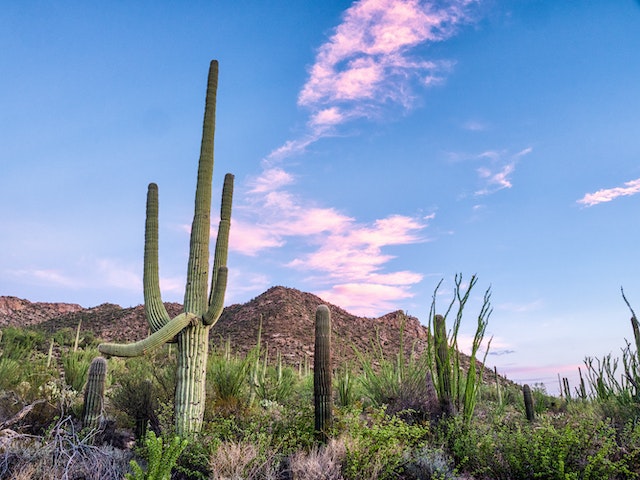
How do cactuses survive in the desert? They have adaptations in their roots, leaves, and stems that help them retain water and survive in desert conditions.
There are about 2,000 different types of cactus. All types of cactus are native to the Americas, except for the mistletoe cactus, which is found across Africa. The main theory is that even this was native to the Americas, but seeds were carried to Africa by birds. The word “cactus” comes from Latin, which in turn came from the Greek “kaktos”, which was the name for a spiny plant in Greece. Incidentally, the plural of cactus can be both cacti and cactuses. In English, we add the “es” to make a plural but in Latin, where the word came from, a “us” ending is pluralized to “i”. Some people like to say cactus and cacti, but we don’t say campus and campi. So, I’m going to use cactuses here.
We’re looking at how cactuses survive in the desert, but not all cactuses live in the desert. You can find cactuses in the mountains and in rainforests. However, no matter where they live, all cactuses share the adaptations that make them ideal for living in a desert. Let’s look at these adaptations from the bottom up.
Cactuses have extensive root systems. However, these roots don’t go deep into the ground, they spread out and stay just beneath the surface. We might think that cactuses would try to send their roots as deep as possible, looking for water, but that isn’t necessarily the best idea in a desert. It does rain sometimes in the desert and by spreading their roots out over a large area, cactuses increase the surface area of their roots and the chance that they will catch more water. In fact, when it does rain, the cactus will rapidly grow more roots to take advantage of the rain.
The stem of the cactus is the next adaptation for retaining water. They are succulents, which means they have special tissue that works like a sponge. They also have ribs and creases that allow them to shrink when there is no water and expand when they are full of water. The cylindrical or round shape of the cactus is another advantage because it reduces the surface-area to volume ratio. As we learned when we looked at how small or large a mammal could be, if something has a large volume but small surface area, it will lose heat. This keeps the cactuses cool and stops the water evaporating away. The stems are covered in a waxy cuticle that keeps water in, as well. This layer stops the cactus from drying out and can reflect away heat.
The stems of the cactus have evolved another trick to keep in water. Cactuses don’t have leaves, the reason for which we shall get to in a moment, which means they need another way of photosynthesizing. They do this through their stems. However, when a plant photosynthesizes, they open up small pores to take in carbon dioxide, and they lose water in the process. Most plants don’t have a water problem and they take in CO2 and lose water all day long. Cactuses can’t afford to do this, so they open their pores when it gets dark and take in CO2, which they store to be used the next day for photosynthesis. It is cooler at night, and they lose far less water this way.
The last adaptation is the leaves, or the lack of leaves. You might not think it, but cactuses do have leaves. The razor-sharp spines that stick out them all over the place are actually leaves. They have evolved away from the traditional leaf shape because it would increase the surface area of the cactus and increase the amount of water lost. This is the reason why they have to photosynthesize through their stem.
These leaves aren’t just for decoration. They have four excellent uses. The first is protection. It is very difficult for an animal to eat a cactus because of the spines sticking out of it. The second is cooling down the cactus. They can trap a layer of air near the surface of the cactus, which keeps moisture close to the plant and stops it evaporating away. The third thing is that they provide some shade for the cactus, reducing its temperature. And the fourth thing is that they catch the moist air in the early morning so that it condenses on the spines and their shape directs the drips of water down to the roots of the cactus. All of these adaptations help cactuses survive in the desert and this is what I learned today.
Photo by Raychel Sanner: https://www.pexels.com/photo/cactus-plants-on-hill-under-blue-sky-4686145/
Sources
https://en.wikipedia.org/wiki/Cactus
https://byjus.com/biology/how-are-cactus-adapted-to-survive-in-a-desert/
https://www.livescience.com/4188-cacti-survive-surprising-strategies-quench-thirst.html
https://cactusway.com/how-the-cactus-is-adapted-to-the-desert/
https://eduscapes.com/nature/cactus/index3.htm
https://www.cs.mcgill.ca/~rwest/wikispeedia/wpcd/wp/c/Cactus.htm
https://cactusway.com/what-kind-of-cactus-live-in-the-desert/
